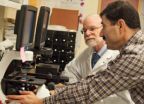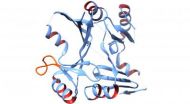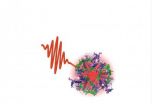(Press-News.org) Neurotensin conjugate provides pain relief in animal models
The small peptide neurotensin is a potent regulator of dopamine signaling and can provide dramatic pain relief; however, the blood brain barrier provides a substantial challenge toward clinical use of neurotensin for analgesia. In this issue of the Journal of Clinical Investigation, Philippe Sarret and colleagues at Université de Sherbrooke generated a conjugate of neurotensin with a peptide able to cross the blood brain barrier and evaluated the analgesic effects of this molecule in animal models of pain. The authors observed efficient transportation of the conjugate (ANG2002) across the blood brain barrier and dose-dependent pain relief in multiple models. The results from this study suggest that ANG2002 has potential to be effective for clinical pain management.
TITLE: Conjugation of a brain-penetrant peptide with neurotensin provides antinociceptive properties
AUTHOR CONTACT: Philippe Sarret
Université de Sherbrooke, Sherbrooke, PQ, CAN
Phone: 819-820-6868 #12554; Fax: 819-820-6887; E-mail: philippe.sarret@usherbrooke.ca
View this article at: http://www.jci.org/articles/view/70647?key=d7ec1ecdc3b327ae271a
T cell repertoire following hematopoietic stem cell transplant
A promising treatment for hematologic and other malignancies is the transplantation of hematopoietic stem cells isolated from the patient. The use of an individuals own stem cells reduces complications involved with graft rejection;however, many patients develop autoimmune disease or other complications following the procedure. In this issue of the Journal of Clinical Investigation, Laurence Turka and colleagues from Massachusetts General Hospital evaluated the T cell response in a cohort of poor-prognosis MS patients following hematopoietic stem cell transplantation (HSCT) and determined that HSCT had differential effects on T cell repertoire. Importantly, patients with a diverse T cell population following the procedure were more likely to respond well to treatment.
TITLE: T cell repertoire renewal following autologous stem cell transplantation for multiple sclerosis
AUTHOR CONTACT: Laurence A. Turka
Massachusetts General Hospital, Boston, MA, USA
Phone: 617 724-7711; Fax: ; E-mail: lturka@partners.org
View this article at: http://www.jci.org/articles/view/71691?key=b64763243f594bab6646
ALSO IN THIS ISSUE
TITLE: Serotonergic mechanisms responsible for levodopa-induced dyskinesias in Parkinson's disease patients
AUTHOR CONTACT: Marios Politis
Imperial College London, London, , GBR
Phone: +4402083833754; E-mail: marios.politis@imperial.ac.uk
View this article at: http://www.jci.org/articles/view/71640?key=53290de4e3538ea486e7
TITLE: Metformin interferes with bile acid homeostasis through AMPK-FXR crosstalk
AUTHOR CONTACT: Philippe Lefebvre
INSERM, LILLE, , FRA
Phone: +33.3209774220; E-mail: philippe-claude.lefebvre@inserm.fr
View this article at: http://www.jci.org/articles/view/68815?key=b6447701e370aab5dcf0
TITLE: Podocyte-associated talin1 is critical for glomerular filtration barrier maintenance
AUTHOR CONTACT: Shuta Ishibe
Yale University School of Medicine, New Haven, CT, USA
Phone: 203-737-4170; Fax: 203-785-4904; E-mail: shuta.ishibe@yale.edu
View this article at: http://www.jci.org/articles/view/69778?key=b2362d17c39fcc7d7ef2
TITLE: Cyclin-dependent kinase inhibitor 2B regulates efferocytosis and atherosclerosis
AUTHOR CONTACT: Nicholas Leeper
Stanford University School of Medicine, Stanford, CA, USA
Phone: 415-794-7712; E-mail: nleeper@stanford.edu
View this article at: http://www.jci.org/articles/view/70391?key=7731007a399ee021075e
TITLE: Abnormal muscle mechanosignaling triggers cardiomyopathy in mice with Marfan syndrome
AUTHOR CONTACT: Francesco Ramirez
Mount Sinai School of Medicine, New York, NY, USA
Phone: 212-241-7237; Fax: 212-996-7214; E-mail: francesco.ramirez@mssm.edu
View this article at: http://www.jci.org/articles/view/71059?key=10982d70689da49c44ac
TITLE: Lipotoxic disruption of NHE1 interaction with PI(4,5)P2 expedites proximal tubule apoptosis
AUTHOR CONTACT: Jeffrey Schelling
Case Western Reserve University, Cleveland, OH, USA
Phone: (216)778-3079; Fax: (216)778-4321; E-mail: :Jeffrey.schelling@case.edu
View this article at: http://www.jci.org/articles/view/71863?key=0ce2eb6cd213e7f0230e
TITLE: Bitter and sweet taste receptors regulate human upper respiratory innate immunity
AUTHOR CONTACT: Noam Cohen
Perelman School of Medicine at the University of Pennsylvania, Philadelphia, PA, USA
Phone: 215-823-5800 ext 3892; Fax: 215-349-5977; E-mail: cohenn@uphs.upenn.edu
View this article at: http://www.jci.org/articles/view/72094?key=80384aee45c4752a4dd2
TITLE: Extracellular caspase-6 drives murine inflammatory pain via microglial TNF-α secretion
AUTHOR CONTACT: Ru-Rong Ji
Duke University Medical Center, Durham, NC, USA
Phone: 919-684-9687; E-mail: u-rong.ji@duke.edu
View this article at: http://www.jci.org/articles/view/72230?key=e5732c9ba6685986b16a
INFORMATION:
JCI early table of contents for Feb. 17, 2014
2014-02-17
ELSE PRESS RELEASES FROM THIS DATE:
Extensive renewal of the T cell repertoire following autologous stem cell transplant in MS
2014-02-17
WA, Seattle (February 17, 2014) – A new study describes the complexity of the new T cell repertoire following immune-depleting therapy to treat multiple sclerosis, improving our understanding of immune tolerance and clinical outcomes.
In the Immune Tolerance Network's (ITN) HALT-MS study, 24 patients with relapsing, remitting multiple sclerosis received high-dose immunosuppression followed by a transplant of their own stem cells, called an autologous stem cell transplant, to potentially reprogram the immune system so that it stops attacking the brain and spinal cord. ...
Finding common ground fosters understanding of climate change
2014-02-17
EAST LANSING, Mich. — Grasping the concept of climate change and its impact on the environment can be difficult. Establishing common ground and using models, however, can break down barriers and present the concept in an easily understood manner.
In a presentation at this year's meeting of the American Association for the Advancement of Science, Michigan State University systems ecologist and modeler Laura Schmitt-Olabisi shows how system dynamics models effectively communicate the challenges and implications of climate change.
"In order to face the ongoing challenges ...
Small non-coding RNAs could be warning signs of cancer
2014-02-17
Small non-coding RNAs can be used to predict if individuals have breast cancer conclude researchers who contribute to The Cancer Genome Atlas project. The results, which are published in EMBO reports, indicate that differences in the levels of specific types of non-coding RNAs can be used to distinguish between cancerous and non-cancerous tissues. These RNAs can also be used to classify cancer patients into subgroups of individuals that have different survival outcomes.
Small non-coding RNAs are RNA molecules that do not give rise to proteins but which may have other ...
New finding points to potential options for attacking stem cells in triple-negative breast cancer
2014-02-17
ANN ARBOR, Mich. — New research from the University of Michigan Comprehensive Cancer Center and Georgia Regents University finds that a protein that fuels an inflammatory pathway does not turn off in breast cancer, resulting in an increase in cancer stem cells. This provides a potential target for treating triple negative breast cancer, the most aggressive form of the disease.
The researchers identified a protein, SOCS3, that is highly expressed in normal cells but undetectable in triple-negative breast cancer. They showed that this protein is degraded in cancers, blocking ...
Religious and scientific communities may be less combative than commonly portrayed
2014-02-17
One of the largest surveys of American views on religion and science suggests that the religious and scientific communities may be less combative than is commonly portrayed in the media and in politics.
Only 27 percent of those surveyed said that they viewed science and religion as being in conflict with each other, with about equal percentages of those people "siding with either religion or science," said Rice University sociologist Elaine Howard Ecklund at the AAAS Annual Meeting. The survey was commissioned by the AAAS Dialogue on Science, Ethics and Religion (DoSER) ...
Uncovering the secrets of tularemia, the 'rabbit fever'
2014-02-17
WASHINGTON D.C. Feb. 16, 2014 -- Tularemia, aka "rabbit fever," is endemic in the northeastern United States, and is considered to be a significant risk to biosecurity -- much like anthrax or smallpox -- because it has already been weaponized in various regions of the world.
At the 58th Annual Biophysical Society Meeting, which takes place Feb. 15-19, 2014, in San Francisco, Calif., Geoffrey K. Feld, a Postdoctoral researcher in the Physical & Life Sciences Directorate at Lawrence Livermore National Laboratory (LLNL), will describe his work to uncover the secrets of the ...
Bacterial superbug protein structure solved
2014-02-17
WASHINGTON D.C. Feb. 16, 2014 -- A research team from Vanderbilt University Medical Center in Nashville, Tenn., is the first to decipher the 3-D structure of a protein that confers antibiotic resistance from one of the most worrisome disease agents: a strain of bacteria called methicillin-resistant Staphylococcus aureus (MRSA), which can cause skin and other infections. The Vanderbilt team's findings may be an important step in combatting the MRSA public health threat over the next 5 to 10 years.
By deciphering the shape of a key S. aureus protein -- an enzyme called ...
Harvesting light, the single-molecule way
2014-02-17
WASHINGTON D.C. Feb. 16, 2014 -- New insights into one of the molecular mechanisms behind light harvesting, the process that enables photosynthetic organisms to thrive, even as weather conditions change from full sunlight to deep cloud cover, will be presented at the 58th Annual Biophysical Society Meeting, taking place in San Francisco from Feb. 15-19.
At the meeting, Hsiang-Yu Yang, a graduate student, and Gabriela Schlau-Cohen, a postdoc in W.E. Moerner's research group at Stanford University, will describe how probing these natural systems at the single molecule level ...
Deep ocean needs policy, stewardship where it never existed
2014-02-17
BEAUFORT, N.C. -- Technological advances have made the extraction of deep sea mineral and precious metal deposits feasible, and the dwindling supply of land-based materials creates compelling economic incentives for deep sea industrialization. But at what cost?
“We’re really in the dark when it comes to the ecology of the deep sea," said Linwood Pendleton, director of the Ocean and Coastal Policy Program at the Nicholas Institute for Environmental Policy Solutions at Duke University. "We know a lot about a few places, but nobody is dealing with the deep sea as a whole, ...
Obesity in Samoa: A global harbinger?
2014-02-17
PROVIDENCE, R.I. [Brown University] — The South Pacific archipelago of Samoa and American Samoa harbors a global health mystery that may seem both remote and extreme but could foretell trends in obesity and related conditions across much of the developing world.
About three-quarters of the U.S. territory's adult population is obese, the highest rate in the world with independent Samoa quickly catching up. Rates of type 2 diabetes top one in five and a recent study found that the elevated obesity rates are present even in newborns.
This pandemic began only a few decades ...




